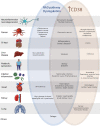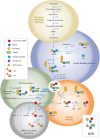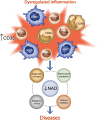The CD38 glycohydrolase and the NAD sink: implications for pathological conditions
- PMID: 35138178
- PMCID: PMC8917930
- DOI: 10.1152/ajpcell.00451.2021
The CD38 glycohydrolase and the NAD sink: implications for pathological conditions
Abstract
Nicotinamide adenine dinucleotide (NAD) acts as a cofactor in several oxidation-reduction (redox) reactions and is a substrate for a number of nonredox enzymes. NAD is fundamental to a variety of cellular processes including energy metabolism, cell signaling, and epigenetics. NAD homeostasis appears to be of paramount importance to health span and longevity, and its dysregulation is associated with multiple diseases. NAD metabolism is dynamic and maintained by synthesis and degradation. The enzyme CD38, one of the main NAD-consuming enzymes, is a key component of NAD homeostasis. The majority of CD38 is localized in the plasma membrane with its catalytic domain facing the extracellular environment, likely for the purpose of controlling systemic levels of NAD. Several cell types express CD38, but its expression predominates on endothelial cells and immune cells capable of infiltrating organs and tissues. Here we review potential roles of CD38 in health and disease and postulate ways in which CD38 dysregulation causes changes in NAD homeostasis and contributes to the pathophysiology of multiple conditions. Indeed, in animal models the development of infectious diseases, autoimmune disorders, fibrosis, metabolic diseases, and age-associated diseases including cancer, heart disease, and neurodegeneration are associated with altered CD38 enzymatic activity. Many of these conditions are modified in CD38-deficient mice or by blocking CD38 NADase activity. In diseases in which CD38 appears to play a role, CD38-dependent NAD decline is often a common denominator of pathophysiology. Thus, understanding dysregulation of NAD homeostasis by CD38 may open new avenues for the treatment of human diseases.
Keywords: CD38; NAD metabolism; diseases.
Conflict of interest statement
E.N.C holds a patent on CD38 inhibitors licensed by Elysium Health. E.N.C. consults for Calico, Mitobridge, and Cytokinetics. None of the other authors has any conflicts of interest, financial or otherwise, to disclose.
Figures




Similar articles
-
Heavy-chain antibody targeting of CD38 NAD+ hydrolase ectoenzyme to prevent fibrosis in multiple organs.Sci Rep. 2023 Dec 12;13(1):22085. doi: 10.1038/s41598-023-49450-1. Sci Rep. 2023. PMID: 38086958 Free PMC article.
-
Regulation of intracellular levels of NAD: a novel role for CD38.Biochem Biophys Res Commun. 2006 Jul 14;345(4):1386-92. doi: 10.1016/j.bbrc.2006.05.042. Epub 2006 May 15. Biochem Biophys Res Commun. 2006. PMID: 16730329
-
Enzyme properties of Aplysia ADP-ribosyl cyclase: comparison with NAD glycohydrolase of CD38 antigen.J Biochem. 1995 Jan;117(1):125-31. doi: 10.1093/oxfordjournals.jbchem.a124698. J Biochem. 1995. PMID: 7775378
-
The Pharmacology of CD38/NADase: An Emerging Target in Cancer and Diseases of Aging.Trends Pharmacol Sci. 2018 Apr;39(4):424-436. doi: 10.1016/j.tips.2018.02.001. Epub 2018 Feb 23. Trends Pharmacol Sci. 2018. PMID: 29482842 Free PMC article. Review.
-
CD38 as a regulator of cellular NAD: a novel potential pharmacological target for metabolic conditions.Curr Pharm Des. 2009;15(1):57-63. doi: 10.2174/138161209787185788. Curr Pharm Des. 2009. PMID: 19149603 Free PMC article. Review.
Cited by
-
NADPH and Mitochondrial Quality Control as Targets for a Circadian-Based Fasting and Exercise Therapy for the Treatment of Parkinson's Disease.Cells. 2022 Aug 4;11(15):2416. doi: 10.3390/cells11152416. Cells. 2022. PMID: 35954260 Free PMC article. Review.
-
NAD metabolism: Role in senescence regulation and aging.Aging Cell. 2024 Jan;23(1):e13920. doi: 10.1111/acel.13920. Epub 2023 Jul 9. Aging Cell. 2024. PMID: 37424179 Free PMC article. Review.
-
Targeting CD38 in Antibody-Mediated Rejection.Transpl Int. 2025 May 15;38:14343. doi: 10.3389/ti.2025.14343. eCollection 2025. Transpl Int. 2025. PMID: 40444214 Free PMC article. Review.
-
Heavy-chain antibody targeting of CD38 NAD+ hydrolase ectoenzyme to prevent fibrosis in multiple organs.Sci Rep. 2023 Dec 12;13(1):22085. doi: 10.1038/s41598-023-49450-1. Sci Rep. 2023. PMID: 38086958 Free PMC article.
-
Unveiling the role of NAD glycohydrolase CD38 in aging and age-related diseases: insights from bibliometric analysis and comprehensive review.Front Immunol. 2025 Jun 2;16:1579924. doi: 10.3389/fimmu.2025.1579924. eCollection 2025. Front Immunol. 2025. PMID: 40529366 Free PMC article.
References
-
- Racker E. From Pasteur to Mitchell: a hundred years of bioenergetics. Fed Proc 39: 210–215, 1980. - PubMed
Publication types
MeSH terms
Substances
Grants and funding
LinkOut - more resources
Full Text Sources
Research Materials

